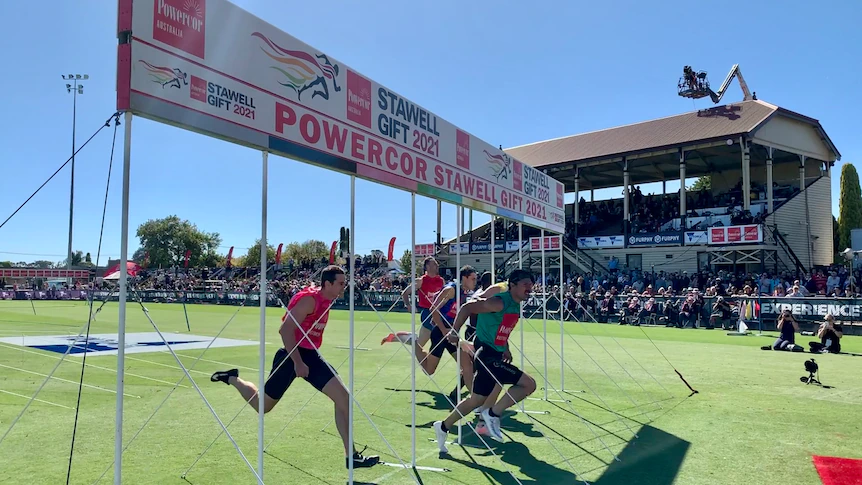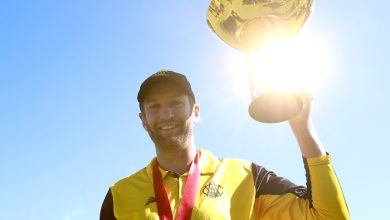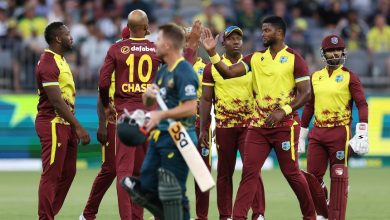Stawell Gift makes triumphant 2021 return as Australia’s richest footrace

The winner of the men’s event in the Stawell Gift says he trained religiously during lockdown, but nothing could have prepared him for the “amazing” victory as the race returned after being cancelled last year.
Table of Contents
Key points:
- The Stawell Gift has returned in 2021 after the pandemic forced it to be cancelled for only the fifth year since 1878
- South Australian sprinter Hayley Orman took out the women’s title
- The men’s race was won by Melbourne sprinter Edward Ware
Victorian sprinter Edward Ware won the men’s event, while the women’s race was won by South Australian Hayley Orman.
Last year’s cancellation of the 120-metre, $40,000 race was the fifth in its history since 1878.
Ware, who ran in his third final, told Channel Seven he had trained hard during last year’s lockdown.
“Train in the morning, getting up at 6:00am, religiously doing sessions at quarter to seven, day in, day out,” he said.
“Didn’t come here expecting this … mate this is amazing.”
ABC News: Patrick Rocca
)Orman, 27, said winning the race was a dream come true after a rocky season.
“I’ve been so injured. There was a period of time where I was like, I may as well write this season off, but I just didn’t give up and I believed in myself and it just happened,” she said.
“I just can’t believe it.”
Crowds bring welcome tourism boost
A capacity crowd of 5,000 people watched the 139th Stawell Gift, including visitors from Melbourne.
Stawell cafe manager Matthew D’Rozario said the weekend had been even busier than 2019, when the Gift last ran.
“The whole area was fully booked and business was very good,” he said.
“We didn’t think it would be that big this year, so we want to say thanks to everyone who supported the Gift.
“We have had to get relatives from Melbourne up to help because of how busy we’ve been!”
Iconic footrace runs in family histories
ABC Wimmera: Alexander Darling
)It is tempting to think that 20-year-old Geordie Hore was destined to be a runner, being the son of Steve Hore and Emma Yeomans — both of whom also ran professionally in the 1990s.
Back for 2021 after being cancelled last year due to COVID-19, they are one of many examples of how the Stawell Gift is a family affair at its heart.
As a child, Geordie became familiar with the stories of his parents’ exploits, and of Cathy Freeman’s iconic 1996 run at the gift where she won a 400-metre event in 50 seconds with a 54-metre handicap.
Incidentally, his mother was one of the other runners in that race.
Loading
But middle distance runner Geordie, who competed in two events at the 2021 gift, said his interest in running developed organically.
“It was never forced on me. I always seemed to enjoy running,” he said.
“Obviously with Mum and Dad having a running background, them being able to support me, was helpful because they knew the steps to take to become a good athlete.”
He is especially grateful to have had the expertise of two professionals close at hand last year when restrictions upended his typical training set-up.
His father Steve, who won three middle distance races in his days at the gift, is also Geordie’s coach.
“If Geordie went out for a run I’d just jump on the bike and ride along next to him,” he said.
“Or if he was doing reps I’d be trying to push the pace a bit.”
It runs in the family, literally
The word “family” has a compound meaning when referring to Victoria’s running community, as Zoe Nicholson has found out in recent years.
ABC Wimmera: Alexander Darling
)The Ararat local won the 800-metre women’s final in 2017 only two years after switching back to running from cycling, which she took up after getting injured at Little Athletics as a girl.
“A couple of my best friends were running and I got into the school state relay team with them. I was training with them, and I continued training and got into the Victorian Athletics League. It just went from there,” Nicholson said.
“We’ve got a few people I train with running this weekend — Laura McDougall, Jess Burns, and my younger sister Caitlin, and a couple of boys all from the Stawell-Ararat area.
“I love running, so when I got injured the goal was to find my way back.
“Getting that push from my friends to come along to training really helped. I’m not sure if I would have come back without that.”
Nicholson bowed out of the gift on Sunday in heat five of the 400-metre Lorraine Donnan Women’s Handicap race.
ABC Wimmera: Alexander Darling
)It keeps on giving
While the men’s and women’s 120-metre races each Easter Monday are the Stawell Gift that turns runners into legends, the carnival spreads across three days and dozens of events at Stawell’s Central Park.
Steve Hore said the gift served as the final last race in the Victorian pro-running season.
“It’s like the grand final,” he said.
“You have a few lead-in races, but everyone wants to be peaking this weekend.”
He said the social aspect of running is what made the gift a tradition.
“Certainly over this weekend there are a lot of families involved,” he said.
ABC Wimmera: Alexander Darling
)Like its entrants, the event keeps on running
Last year, like every other event that could not go online, the Stawell Gift was cancelled.
Australia’s richest footrace, dating back to 1878, had only previously been sidelined for four years during World War II.
Even before COVID-19 there were no guarantees the gift would run long term.
It lost the support of major sponsors in February 2019, forcing it to reduce the prize money for the winner from $40,000 to $15,000.
This was restored later that month after an agreement between the state government, Northern Grampians Shire Council, and the Stawell Athletic Club, but in December of that year the athletic club rejected a long-term funding agreement from the government contingent on changes being made.
A breakthrough came last November when the club signed a sponsorship deal to keep the race televised, and to receive $1.22 million from the state government for four years.
A new organisation, Stawell Gift Event Management Limited, now oversees the race.
Its director is Dustin Lockett, a finalist at the gift in 1997.
He is confident the event’s long-term future is now secure.
“We are seeing the fruits of that labour in the six to eight months since the management team has come together,” Lockett said.
“We’ve brought in other partners and a new ticketing system we’ve never had before. That means we get data and things.”
Why do they run?
Zoe Nicholson said having a local footrace being considered the ultimate was a special feeling for her and her stable.
But it was not the reason she was a runner.
“Whereas in running, as much as we have our own team, it’s very much an individual sport.
“If you don’t run well you’re only letting yourself down, so I think there’s less pressure in that instance.”
An Athletics Australia spokesperson told the ABC that anecdotally COVID-19 had seen an upswing in interest and participation in running for health and fitness — given it was one of the only activities people could undertake while restrictions were in place.
If data ultimately proves this to be the case, it will continue a trend that began in the early 2000s where solo sporting activities and non-sport related activities were more popular among Australians than team sports.




